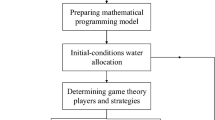Abstract
China Tarim River Basin is located in an arid area, whose rapid socioeconomic development intensifies the current water resources shortage. To allocate water resources reasonably, this paper introduces the bankruptcy theory into the cooperative game model to contract a linear function describing the degree of satisfaction of each region’s declared water demand. Bankruptcy theory solves the problem of insufficient information about stakeholders in the cooperative game. From the perspective of the cooperative game’s stability, the bankruptcy allocation stability index (BASI) is used to evaluate and compare water resource allocation results in the Tarim River Basin in 2025 and 2030 under different scenarios. Moreover, this paper uses the improved TOPSIS model to build the harmony index of water-economy-environment (HWEE) to evaluate the harmony of water resources, economy, and environment in each region. The results show that the model is more suitable for the actual water allocation game and has a good application value than the classical bankruptcy theory. Moreover, the stability index and HWEE proposed in this paper also have better applicability, and the allocation scheme with the same game weight in each region is more stable.





Similar content being viewed by others

Data availability
The datasets used and/or analyzed during the current study are available from the corresponding author on reasonable request.
References
Abrishamchi A, Ebrahimian A, Tajrishi M, Marino MA (2005) Case study: application of multicriteria decision making to urban water supply. J Water Resour Plan Manag 131(4):326–335. https://doi.org/10.1061/(asce)0733-9496(2005)131:4(326)
Bender MJ, Simonovic SP (2000) A fuzzy compromise approach to water resource systems planning under uncertainty. Fuzzy Sets Syst 115(1):35–44. https://doi.org/10.1016/s0165-0114(99)00025-1
Cohon JL, Marks DH (1975) Computational and formulation considerations in multiobjective analysis in water resource planning. In: Proceedings of the 6th Triennial World Congress of the International Federation of Automatic Control, vol 48 5/1-7
Dinar A, Ratner A, Yaron D (1992) Evaluating cooperative game-theory in water-resources. Theor Decis 32(1):1–20. https://doi.org/10.1007/bf00133625
Eleftheriadou E, Mylopoulos Y (2008) Game theoretical approach to conflict resolution in transboundary water resources management. J Water Resour Plan Manag 134(5):466–473. https://doi.org/10.1061/(asce)0733-9496(2008)134:5(466)
Fan R, Wang D, Mao C, Shangkang O, Lian Z, Huang S, Lin Q, Ding R, She J (2012) Preliminary study of children’s exposure to pahs and its association with 8-hydroxy-2′-deoxyguanosine in Guangzhou, China. Environ Int 42:53–58. https://doi.org/10.1016/j.envint.2011.03.021
Fattahi P, Fayyaz S (2010) A compromise programming model to integrated urban water management. Water Resour Manag 24(6):1211–1227. https://doi.org/10.1007/s11269-009-9492-4
Fu X, Lu F, Hu T (2016) Game theory in water resources allocation for stakeholders. J Hydraul Eng 47(1):38–43
Fu J, Zhong P-A, Xu B, Zhu F, Chen J, Li J (2021) Comparison of transboundary water resources allocation models based on game theory and multi-objective optimization. Water 13(10). https://doi.org/10.3390/w13101421
Gao S, Guo H, Jing Y (2021) Urban water inclusive sustainability: evidence from 38 cities in the Yangtze River Economic Belt in China. Sustainability 13(4). https://doi.org/10.3390/su13042068
Harsanyi JC (1961) A simplified bargaining model for the N-person cooperative game. Econometrica 29(3):436–436
Kapetas L, Kazakis N, Voudouris K, McNicholl D (2019) Water allocation and governance in multi-stakeholder environments: insight from Axios Delta, Greece. Sci Total Environ 695:133831. https://doi.org/10.1016/j.scitotenv.2019.133831
Li J, Qiao Y, Lei X, Kang A, Wang M, Liao W, Wang H, Ma Y (2019) A two-stage water allocation strategy for developing regional economic-environment sustainability. J Environ Manag 244:189–198. https://doi.org/10.1016/j.jenvman.2019.02.108
Madani K (2011) Hydropower licensing and climate change: insights from cooperative game theory. Adv Water Resour 34(2):174–83. https://doi.org/10.1016/j.advwatres.2010.10.003
Madani K, Zarezadeh M, Morid S (2014) A new framework for resolving conflicts over transboundary rivers using bankruptcy methods. Hydrol Earth Syst Sci 18(8):3055–3068. https://doi.org/10.5194/hess-18-3055-2014
Mianabadi H, Mostert E, Zarghami M, van de Giesen N (2014) A new bankruptcy method for conflict resolution in water resources allocation. J Environ Manag 144:152–159. https://doi.org/10.1016/j.jenvman.2014.05.018
Quinn NWT, Brekke LD, Miller NL, Heinzer T, Hidalgo H, Dracup JA (2004) Model integration for assessing future hydroclimate impacts on water resources, agricultural production and environmental quality in the San Joaquin Basin, California. Environ Model Softw 19(3):305–316. https://doi.org/10.1016/s1364-8152(03)00155-5
Read L, Madani K, Inanloo B (2014) Optimality versus stability in water resource allocation. J Environ Manag 133:343–354. https://doi.org/10.1016/j.jenvman.2013.11.045
Rohmat FIW, Gates TK, Labadie JW (2021) Enabling improved water and environmental management in an irrigated river basin using multi-agent optimization of reservoir operations. Environ Model Softw 135. https://doi.org/10.1016/j.envsoft.2020.104909
Wang X, Zhang Y, Zeng Y, Liu C (2013) Resolving trans-jurisdictional water conflicts by the Nash bargaining method: a case study in Zhangweinan Canal Basin in North China. Water Resour Manag 27(5):1235–1247. https://doi.org/10.1007/s11269-012-0233-8
Wei S, lin LA, Albrecht G (2009) Application of game theoretic models to solve the benefit conflicts in water resources management. J Hydraul Eng 40(8):910–918
Yin Qiaoyun, Niu Ke, Ning Li, Ieee (2017) "Using Cv-critic to determine weights for smart city evaluation." In Ieee 29th International Conference on Tools with Artificial Intelligence. Proceedings-International Conference on Tools with Artificial Intelligence, 996-1000, 2017
Zeitoun M, Allan JA (2008) Applying hegemony and power theory to transboundary water analysis. Water Policy 10:3–12. https://doi.org/10.2166/wp.2008.203
Acknowledgements
The authors sincerely thank all reviewers and editors for their valuable suggestions.
Funding
This work has been supported by the National Natural Science Foundation of China (grant no. 51979275).
Author information
Authors and Affiliations
Contributions
Jiahe Tian: conceptualization, methodology, software, formal analysis, writing—original draft
Yang Yu: conceptualization, methodology
Tongshu Li: investigation, data curation, writing—review and editing
Yi Zhou: investigation, data curation
Jingjun Li: visualization
Xingpeng Wang: resources
Yu Han: conceptualization, validation, writing—review and editing, supervision, funding acquisition
Corresponding author
Ethics declarations
Ethics approval and consent to participate
Not applicable.
Consent for publication
Not applicable.
Competing interests
The authors declare no competing interests.
Additional information
Responsible Editor: Ilhan Ozturk
Publisher’s note
Springer Nature remains neutral with regard to jurisdictional claims in published maps and institutional affiliations.
Rights and permissions
About this article
Cite this article
Tian, ., Yu, Y., Li, T. et al. A cooperative game model with bankruptcy theory for water allocation: a case study in China Tarim River Basin. Environ Sci Pollut Res 29, 2353–2364 (2022). https://doi.org/10.1007/s11356-021-15748-8
Received:
Accepted:
Published:
Issue Date:
DOI: https://doi.org/10.1007/s11356-021-15748-8



